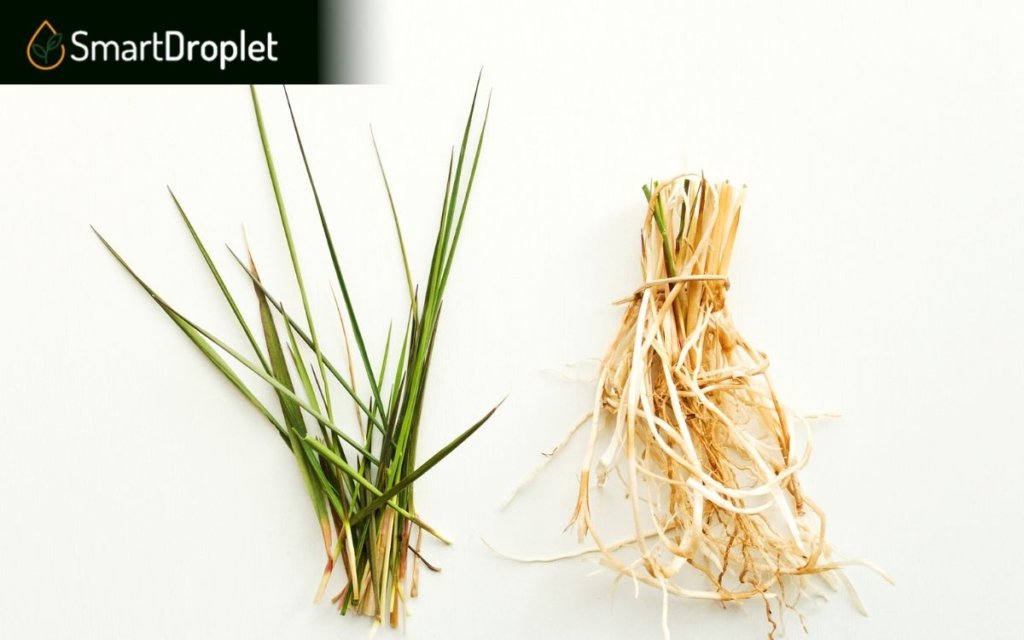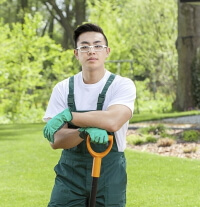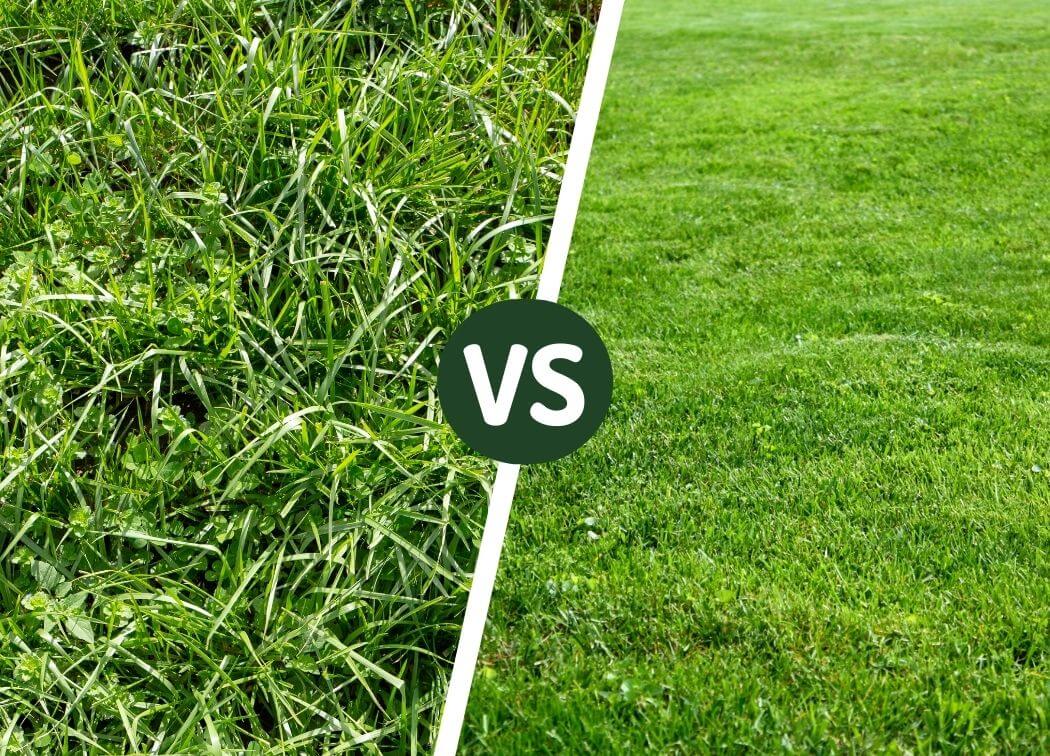In the battle for best turf grass, tall fescue and Kentucky bluegrass (KBG) are the two cool-season types most recommended for your lush green lawn.
The main differences between Kentucky Bluegrass and Tall Fescue are their tolerance levels and appearances. Kentucky Bluegrass leaves are thin with fine texture, while Tall Fescue leaves are wider and sharper. Kentucky Bluegrass is generally more vulnerable to heat, diseases and weeds and also requires nearly 3x more nitrogen fertilizer and twice as much water than Tall Fescue.
However, you might be wondering, “Which one is the better option among the two types of grass?”
Let’s dive deeper into what makes these two kinds of grass different and which one works best for your lawn.
Kentucky Bluegrass vs. Tall Fescue (Differences)
It is important to note the differences between grass types when comparing tall fescue vs. Kentucky bluegrass. These may make… or break your lawn turf.
Here is a table with key differences between Kentucky bluegrass and tall fescue grass.
| Tall Fescue | Kentucky Bluegrass |
| Tall Fescue requires 1 lb of nitrogen fertilizer per 1000 square feet | KBG require 3-6 lbs of nitrogen fertilizer per 1000 square feet |
| Develops bunchy sods and is more traffic-resistant. | Forms dense sods but does not tolerate traffic stress as well. |
| Tall fescue requires only about 1 inch of water every week or 1.5 inches per week when grown in sandy soils. | KBG requires at least 2 inches of water every week. Twice as much water as tall fescue. |
| Is heat-tolerant and resistant to summertime weed invasion and diseases | Vulnerable to weeds and diseases during summer and in generally hot weather. |
| Tall fescues can tolerate moderate shade and require 4 hours of direct sunshine to survive. | KBG tolerates shade but requires at least 8 hours of direct sunshine to survive |
What Are the Best Seed Brands?
For tall fescue seeds, we recommend the Highlander II Fescue Grass Seed mix. It mixes 90% turf-type tall fescue with 10% Kentucky bluegrass seed.
This 90-10 mix creates a nice dark green turf that is durable and requires less water than a full tall fescue bag. You can order a 50 lb bag here.
As for Kentucky bluegrass seeds, we wholeheartedly recommend Barenburg’s Turf Blue HGT with Yellow Jacket Coating.
This bluegrass works in any number of climates. Its Healthy Grass Technology makes it tougher and helps it sprout faster than other brands.
Water Requirements
These grass species require around 1 to 1.5 inches of water a week.
Kentucky bluegrass may require 2 inches of water more often, needing almost double the amount of water as tall fescue.
You will also need to consider if your grass is planted in sandy soils (particularly fescue), as this adds to the amount of water needed.
The cool-season grasses may need up to 2.5 inches of water a week during hot weather periods.
Fertilizer Requirements
To grow, turf-type tall fescue grass needs 1 pound of nitrogen fertilizer for every 1000 square feet of grass.
Kentucky bluegrass, meanwhile, needs more. KBG requires 3-6 pounds of nitrogen fertilizer for every 1000 square feet; 2-5 pounds more than turf-type tall fescue.
Before fertilizing, it is important to conduct a soil test. The best fertilizers may not be enough if the soil is nutrient deficient.
It is best to use a fertilizer spreader to get maximum, even coverage of your entire lawn.
Shade Tolerance
Cool-season grass can survive in less than ideal conditions, such as extreme heat or shade. However, these kinds of grass still need full sun exposure to grow.
Tall fescue requires 4 hours of direct sunlight a day to survive. Kentucky bluegrass is more sensitive, needing at least 8 hours to grow.
Both are heat tolerant to an extent. However, tall fescue makes much better lawn grass in shady areas.
Traffic Tolerance
What good is a lawn if it doesn’t survive foot traffic? Bare feet would better walk on tall fescue, as it tolerates traffic much better than Kentucky bluegrass.
This makes it more suitable for lawn sports and heavier, high foot traffic activities.
Seed Germination Time
In terms of germination, or how long it takes to grow, Kentucky bluegrass seeds take much longer than a tall fescue seed.
Kentucky bluegrass takes around 3 weeks to germinate in ideal conditions. Tall fescue, meanwhile, can take as little as 1 week to germinate.
Sod Formation
Additionally, Kentucky bluegrass rhizomes form dense, underground sods that spread out laterally before breaking the upper surface of the lawn.
On the other hand, tall fescue creates bunch-type growth, making bare patches on the lawn.
More frequent mowing and re-seeding of the grass work wonders to ensure peak growth and prevent bare patches, but Kentucky bluegrass grows neater and more evenly for your lawn.
Weeds and Growth
The last deciding factor is the cool-season grasses’ preferred growing conditions.
Kentucky bluegrass is much more vulnerable to weeds and is not a disease-resistant plant, in comparison to Tall Fescue, during the summer and hot climates.
Meanwhile, turf-type tall fescue is heat-tolerant and has higher disease resistance than bluegrass. It can also weather attacks by invasive weeds, like crabgrass.
It is possible to check the USDA zones and various other affiliate programs to determine how hot your area can get.
Northern and southern regions have different plant hardiness levels, affecting how well your grass grows.
Tall Fescue Identification + Picture

Tall fescue leaves are flat, wide, and have equally-sized veins on the upper surface. Fescues are smooth and shiny on the underside. The stems are 3-4 feet tall, supporting a nodding panicle 4-12 inches long.
The Tall fescue, scientific name Festuca arundinacea, is a heat-tolerant turfgrass species native to Europe. The Kentucky 31 strain has become a mainstay in the grass seed scene.
Despite being a cool-season grass, tall fescue is more heat, drought, and traffic tolerant than the other cool-season turfgrass species.
It thrives in humid temperate regions, growing to about 16-inches tall. It does well in wet-soil regions and doesn’t require much direct sunlight.
Tall fescue grows deep roots, 2-3 feet deep. Despite being a cool-season grass, tall fescue is more heat, drought, and traffic tolerant than the other cool-season turfgrass species.
The extensive fibrous root system allows it to grow in almost any region of the US, save the southernmost regions. This deep root system also makes the grass non-invasive to flower beds.
It is a bunch type grass. Unlike the horizontal growth found in a Kentucky bluegrass lawn, this creates vertical growth and ugly clumps if not mowed constantly.
Tall fescue grass varieties also spot pointed leaf tips. You can identify Tall fescue seeds by their oval shape and tan-brown color.
Kentucky Bluegrass Identification + Picture

Kentucky Bluegrass leaves are thin with fine texture. They can grow anywhere from 6 to 12 inches long and have boat-shaped tips. They appear smooth and have a prominent midrib (vein) running up the middle.
Kentucky bluegrass – scientifically known as Poa pratensis, is a cold season grass that is up there on the list of best turf grass available.
Like perennial ryegrass, thick Kentucky bluegrass spreads quickly during spring, growing a new leaf every 10 days.
Kentucky bluegrass grows better in colder climates, having the greatest cold hardiness among US grass. It would do better in the Northern regions than in the transition zones.
Despite BOTH turf-type tall fescue and Kentucky bluegrass being the cold season kind, the KBG grass type grows through a shallow root system, making it more susceptible to diseases.
Its rhizomes are horizontal stems growing just below the surface. They then push upward and grow a panicle-style seed head when un-mowed.
Its blue-green leaf angles also differ by season. New leaf blades appearing during spring and early summer grow more erect than those from late summer and fall.
They have a 2-year lifespan and can grow to a maximum of 18-24 inches. Due to their dense growth, they are perfect for high foot traffic areas.
Which Grass to Choose
Both Kentucky bluegrass and fescue have their strengths and weaknesses. To choose tall fescue vs. Kentucky bluegrass may come down to your environment.
For example, the transition zone (the central and northern parts of the country) is the most difficult region to grow grass in.
The bleak weather makes summer days too hot and arid for Kentucky bluegrass. However, tall fescue is a heat-tolerant grass that will thrive in the same region, regardless of how hot or cold.
It may be better to mix the two to get the best of both worlds.
In the end, the best turfgrass is the one that grows well in your area, has upkeep you can keep up with, and provides that richly green lawn that works in cooler climates and warmer ones.
Frequently Asked Questions (FAQs)
Here are some of the most frequently asked questions regarding the topic!
If you think you need some additional information about the topic, this section of the article will hopefully help you.
Can I Mix Tall Fescue and Kentucky Bluegrass?
Yes.
Kentucky bluegrass and tall fescue work surprisingly well together when mixed properly.
Mixing the two grass kinds gives you the best of both strains while minimizing their weaknesses.
Lower maintenance, increased resilience, and faster lawn repair are just some of the benefits of combining the two.
The two kinds of grass work best in a combination of 90% tall fescue and 10% Kentucky bluegrass.
It is important to get the proper ratio of 2-4 pounds of seed per 1000 feet by weight when over-seeding a uniform establishment and 4-8 lbs/1000 ft on struggling lawns.
2. Will Bluegrass Overtake Fescue?
When mixing the two grass seeds, a major concern is whether KBG will overtake and outgrow fescue.
This is why, despite getting a 50-50 ratio of seeds, the ideal seed weight is a 90-10 ratio in favor of fescue.
Fescue does better in the shade and requires less maintenance but grows patchy and unsightly when left alone.
Bluegrass, meanwhile, requires more maintenance (hence needing less of it) but fills out bare patches of land much more neatly.
What’s more liable is that they balance each other out due to different growing conditions affected by the climate during different seasons.
References
- Pennstate College of Agricultural Sciences: Bluegrass, Kentucky
- USDA Plant Guide: TALL FESCUE, Lolium arundinaceum
- USDA Plant Guide Fact Sheet: Kentucky Bluegrass, Poa pratensis L.



